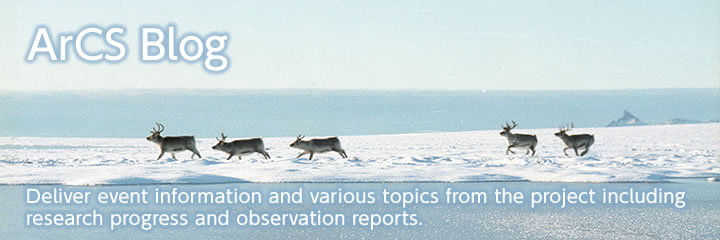The CAFF board meeting held on 5 and 6 September at the Swedish Environmental Protection Agency, Stockholm. This meeting was first- time for the Swedish chair. About forty-five people from fourteen countries attended the meeting. Main work of the meeting was to confirm the present situation for each monitoring and project. As for monitoring, freshwater monitoring report was issued. Since The Circumpolar Biodiversity Monitoring Program(CBMP) expart groups have accumulated knowledge for management, data summarise and so on. It was suggested that chairs of each expert group attend other expert groups to learn above issues. Also, Sustainability of CBMP and facilitation of cross-cutting integration across the four CBMP monitoring groups to be a considered at upcoming scoping workshops meetings. It may be big news for observer countries that CBMP are welcome to receive resources from observer countries to support the CBMP.

A tethered balloon on R/V Mirai is an observing system to measure atmospheric profiles of concentrations and size distributions of aerosols (including black carbon).
We started our expedition to Qeqertat on 12th August after the glacial observation on Qaanaaq Icecap and oceanographic observations in Bowdoin Fjord. Qeqertat is a small village located in the innermost area of Inglefield Fjord, with easy access to the marine-terminating glaciers within the fjord (e.g., Tracy Glacier, Heilprin Glacier).
ArCS Research Theme 2 "Variations in the ice sheet, glaciers, ocean and environment in the Greenland region" studies interaction between the Greenland ice sheet and the ocean. Every summer since 2012, we have carried out field observations around Qaanaaq village in northwestern Greenland. This year in 2019, we went to Bowdoin Glacier located 30 km northeast from Qaanaaq from 1st to 15th July. Field data from glaciers in this region are sparse because of poor accessibility to Qaanaaq area and difficulty in field activity on crevassed ice surface. With this background, we continue glacial field observation to investigate recent changes in glacier flow and their mechanism.
As a part of ‘theme 6’ ecosystem and biodiversity research program, ArCS researchers studied seabirds breeding on St Lawrence Island, Northern Bering Sea. This season is the fourth year of our fieldwork, which started in 2016. Researchers from NIPR and University of Alaska Fairbanks worked together with native guides from St. Lawrence Island, from mid-June to mid-August. I traveled to join the fieldwork during 19 June – 6 July 2019.
I visited Italy and Russia from 14 March to 13 April, 2019 through the support from the ArCS Program for Overseas Visits by Young Researchers. This is the second time that I was able to get support from the program. My first visit in 2017 was to the Sakha Republic, Russia, where I started the polar bear research project with the Yakutian researchers. The main purpose of my second visit was for disseminating the results of our research and meeting with my collaborators for further development of polar bear study in Russia.
From May 18th to June 1st, I visited Alaska through the support from the ArCS Program for Overseas Visits by Young Researchers. The aim of this study is to reveal the process of material cycle associated with sea ice growth and decay and its relationship to marine ecosystem. Sea ice stores abundant nutrients. Sea ice likely supplies nutrients in the ocean during spring or summer melting season, and this has potential impact on the marine ecosystem through biological processes such as phytoplankton bloom.
Project team of ArCS Research Theme 2 "Variations in the ice sheet, glaciers, ocean and environment in the Greenland region" began a summer field campaign in Qaanaaq, northwestern Greenland, to investigate ice sheets/glaciers ocean interaction. One of our focuses is Qaanaaq Ice Cap located north of Qaanaaq Village. We have been measuring surface mass balance and ice flow velocity since 2012. This continuous effort provides us important information about glaciers in northwestern Greenland, where field data are sparse. We installed weather stations and time lapse cameras on the ice cap for continuous observations of snow/ice melting and surface conditions. Our data show exceptionally rapid snow/ice melting this summer. We carefully observe weather and snow/ice conditions to investigate the effects of warm summer on shrinking Qaanaaq Ice Cap.
A workshop titled “Canada-Japan Future Collaboration Workshop on Arctic Environment based at Canadian High Arctic Research Station (CHARS) Campus” was held on Monday, 1 July 2019 and Tuesday, 2 July 2019, at CHARS, Cambridge Bay, Canada. The goal of the workshop was to deliver and exchange information of on-going and future possible research projects in the Arctic environment surrounding Cambridge Bay、Nunavut with Canadian counterparts and local stakeholders. The meeting was organized in collaboration with Canadian counterparts at Polar Knowledge Canada (POLAR) to strengthen the bilateral research collaboration between Canada and Japan.
Accurate weather forecasts form an imperative component of field observational campaigns. Accuracy is important, of course, but understanding the uncertainty is just as crucial. Observations on the hand are vital for Numerical Weather Prediction (NWP) models and centers for numerous reasons: improving forecasts through data assimilation, assessing their performance, and advancing model physics through process evaluations. Maximizing the values of observations and NWPs intuitively require communication between both parties. Aiming to initiate discussions in this context, a leading NWP center, European Centre for Medium-range Weather Forecasts (ECMWF) hosted a workshop during the 10th and 13th of June, 2019, titled “Observational campaigns for better weather forecasts” in Reading, UK. The workshop oral sessions included: model diagnostics using data, cloud physics, tropical cyclones, stratosphere, mountains, and winds, and polar processes. 4 members from the ArCS project participated with the Theme 1 PI presenting an oral talk from a perspective of a NWP user during the 2018 R/V Mirai field campaign while the others had poser presentations regarding sea ice forecast and air temperature biases and uncertainty of satellite-retrieved sea ice concentration. More broadly, discussions during the workshop included how to strengthen the link between observational campaigns and NWP centers, uncertainty estimation of the observation and models, and how to improve numerical models with past observational campaigns.




